THE ANATOMY OF A PARKWAY STRIP
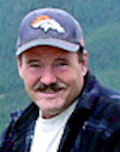
CyberSage (Jack)
FINDING AND RECOGNIZING GOOD HUNTING AREAS
There are miles of parkways in the average city. Anytime you find one in front of older architecture, you stand a good chance of getting those old coins. However, there are things you can look for that will increase the potential for great finds in your hunts. Having a good eye for spotting these telltale clues is key to getting that silver out of the ground and into your keeper pouch. Following are some of the things I look for. This information is based on many past hunts and their respective results. It is important to remember that these are just the perceptions of one detectorist. Use it as a guide and allow for variation according to your hunting environment. Of course, in most situations you will be hunting the entire parkway of a given area, but it doesn't hurt to know the hot spots in advance.
In general the ideal parkway strip is going to be one that is near an older part of town. I have found that the less disturbed the area, the better hunting condition you will have. When you start putting in irrigation and laying down sod, those coins start getting very deep... not just from the extra width of the new sod layer, but additional watering causes more settling in the area. The trees in the strip can tell you a lot about what you are up against in your hunt. The following two examples show a desirable and not-so-desirable hunting scenario.
Exposed roots mean undisturbed ground. The lack of roots means fill and sod have been applied. The coins will be deeper.
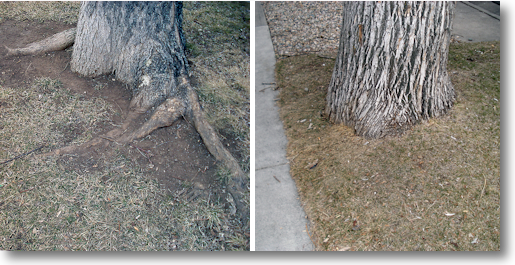
I have found silver just a few inches down in undisturbed ground. Your job gets tougher the more the ground is worked. The exception here is if there has been a deep rototill done to the area. This can actually bring old coins back up to the surface. If there are no trees, the presence of sprinklers and the area having a radically different appearance than other parkways nearby is your clue that the coins will be deeper. My general rule of thumb is the dry neglected parkway is the coinshooter's paradise. Lush, green grass means deeper targets and more of a chance of making a mess out of the parkway with your digging. This plays into rentals versus owner occupied properties. I am going to make a generalization here that does not always hold true. For the most part, you will see more neglected, original ground around rental properties. Parkways around owner occupied properties are usually cared for much better. I have better luck in front of rentals. If you have an old college in your town, the rental areas around the campus will be a coinshooting dream come true. The ground is often powder dry with no grass and full of weeds. Hunt away, no one will ever bother you there.
LISTEN TO THE SIDEWALK
There are other indicators for old ground as well. The most obvious is the sidewalk itself. Most modern era sidewalks in my area have date stamps in them from the contractor who poured the sidewalk. This is an easy way to date the sidewalk. A not-so-apparent method involves a simple comparison of the concrete. The best way to do this is in the morning or evening hours when the sun is lower in the sky. Go to the corner of the block and squat down and look up the sidewalk. Look at the following example...
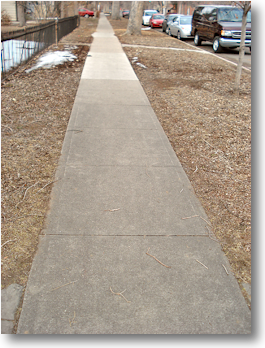
What you will see is that the sidewalk has a story of time to share with you. The older, more oxidized, darker sidewalk stands out now in stark contrast to the lighter, newer pours. You can assume that there is more disturbed ground in the new concrete areas. Note: If the ground is noticeably higher in elevation along the new sections...run, don't walk to these areas and swing that detector. They have thrown the excavation dirt from below the old sidewalk out onto the surface. They dug the coins for you!
Take note of the curbing and gutter as well. You can see the same changes to these areas and apply the same logic when hunting along the edges.
Another uncommon occurrence is to find a handprint of a mischievous child with a date or a name by it. I found one with the name "John" and a date of 1956 by it once. What made this one different is the fact that John also took the time to put his dog's paw mark next to his. LOL! This clue told me that perhaps our little friend may have played and lost a few silver rosies in this area. I ended up not finding any dimes that day, but I did find an old dog tag. I could not make out a date of any kind, but I just had to wonder if I found something that belonged to the canine whose paw print was in the sidewalk. The lesson here is that the past has many ways to tell its story. Be perceptive to these little signs and they will guide you to your treasure...whether it's silver or not.
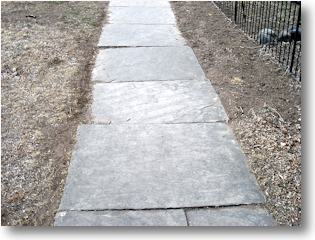
If you find a coin under one of these slabs you can bet it will be an old one!
Learning the history in your area of how the walkways were laid out will aid you in your quest. In my area, I know the original sidewalk was made from stone slabs. Recognizing the slabs is easy and always makes for a good hunt. You know these things have to be heavy! The city governments are slowly replacing these stone slabs, as they pose a tripping hazard and create mobility issues for individuals trying to navigate them with wheelchairs and walkers. When this construction starts it is a fantastic time to detect. I keep a sharp eye out for crews removing the stones in preparation for a concrete pour. You may have just a few hours in the evening to take advantage of this situation. I have found many nice coins in this scenario, and drive the back streets on a regular basis looking for the telltale spray paint marks on the ground that signal construction is about to ensue.
These slabs are highly sought after in my town. The city typically gives the landowner the option of taking them first. They sell for as much as $150 to $200 apiece. I realize this may not apply to you or your city; but if you are ambitious, knock on the door and offer to help move these onto the property in trade for hunting their yard. This is work, but could be the path to that barber or seated half just over the fence in the yard. What I am saying is always look for an opportunity to help out the landowner. It will almost always be to your benefit as well. The sidewalks are the traffic area. I should mention that just off the edge is where dropped coins will roll and come to rest.
While we are on the subject of the sidewalk, let's talk a little about technique with your coil. Do not swing at a 90-degree angle to the sidewalk with your coil. The change in density from stone or concrete to the soil will wreak havoc on the response from your detector. Swing your coil parallel to the edge of the sidewalk with the front of the coil tipped up at an angle and away from the edge a few inches. This will drop the cone of the detector?s field nicely down the edge of the walk. Use this same approach with the curbs and driveways. You can plant a coin and test this out yourself to get the feel of what that coin will sound like in comparison to the different swing styles.
THE PLAY ZONE
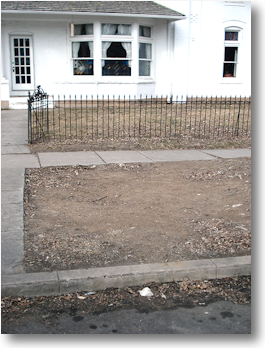
A typical "Play Zone". This one produced a bank token, some old play money, and the real McCoy...several wheats and a mercury dime. Note the alignment with the large bay window.
This favorite hunt area is based on what I refer to as "The Play Zone", and it is exactly that. These are areas that were frequently used by child of past times to play in. I started finding large number of wheats and tokens along with various toys, marbles, jacks, and cast iron cars. I came to realize that these areas must have been a play area. I could just hear Mom saying, "Don't go into the street". With that boundary set, I could also see the children pushing the limit by playing on the parkway just a few feet away. For the longest time, there seemed to be no rhyme or reason as to where these play areas would be...other than in the front of the house near where the sidewalk meets the curb. I couldn't put my finger on it until one day while on a walk, I heard a modern day mother shout from the doorway of the house at her kids, "Stay where I can see you". That was it! After careful re-examination of previous parkways I had hunted, I made the correlation of the main viewing window of the house being in a direct line with the play area finds. The children where allowed to play where their mother could easily glance out the front window every now and then and check up on them. Every time I start a parkway hunt, I go to these locations first. The method is really quite simple. As you approach a parkway in front of an old house, look to see what area would have been most visible to the porch or front window of the house. If you happen to get the opportunity to hunt the owner's property you can use this methodology to find productive areas of the yard as well.
I found my oldest coin in a play area like this. Most of the coins pointed to a Victorian age child. In lieu of real money, it looked as though this child was given old money to play with as well. Imagine my surprise when, along with the wheat pennies from the early teens, I dug an 1806 George III copper!
|